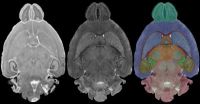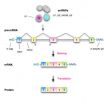Radiation therapy improves painful condition associated with multiple sclerosis
2010-10-26
(Press-News.org) Stereotactic radiation is an effective, long-term treatment for trigeminal neuralgia: a painful condition that occurs with increased frequency in patients with multiple sclerosis (MS). Radiation is noninvasive and has less negative side effects than other treatments, according to the longest follow-up in a study of its kind presented October 31, 2010, at the 52nd Annual Meeting of the American Society for Radiation Oncology (ASTRO).
Multiple sclerosis is a progressive neurological disease affecting about 300,000 Americans where the body's immune system attacks its own nerve cells, affecting the ability of the brain to communicate with the spinal cord. Trigeminal neuralgia is an intensely painful condition caused by dysfunction of the trigeminal nerve, which is one of the nerves that innervates the face. People living with MS see a significantly increased incidence of this problem.
"We studied patients for a median of five years after treatment, which is the longest period of follow-up ever completed," Tejan Diwanji, lead author of the study at the University of Maryland, School of Medicine in Baltimore, said "Our study shows that radiosurgery using Gamma Knife is a proven alternative to surgery or anti-epileptic drugs."
The study was designed to determine the long-term effectiveness of treating trigeminal neuralgia in MS patients with Gamma Knife radiosurgery.
Stereotactic radiation is a specialized type of external beam radiation therapy that uses focused radiation beams to target a well-defined area. It is most often used for tumors of the brain, but in this case, doctors targeted a nerve root, relying on detailed imaging and computerized three-dimensional planning to deliver the radiation dose with extreme accuracy while sparing the surrounding tissue to reduce side effects.
Stereotactic radiation therapy, sometimes called radiosurgery, refers to a single or several treatments to the brain. Doctors in this study used GammaKnife. Other brand names for stereotactic radiation include Axesse, CyberKnife, Novalis, Primatom, Synergy, X-Knife, TomoTherapy or Trilogy.
The study involved 13 MS patients with trigeminal neuralgia who were treated with radiosurgery at the University of Maryland between 1998 and 2001 and were followed for a median of five years after treatment.
"We need more long-term studies to confirm the positive and lasting outcomes of radiosurgery, then it could become the treatment of choice for MS patients afflicted with trigeminal neuralgia," Diwanji, said. "I encourage people with MS suffering from trigeminal neuralgia to talk to their doctor about consulting a radiation oncologist to see if they would be good candidates for radiosurgery."
###
For more information on radiation therapy, visit www.rtanswers.org.
The abstract, "Long-term Outcome of Gamma Knife Stereotactic Radiosurgery for Multiple Sclerosis Associated Trigeminal Neuralgia," will be presented at 10:00 a.m. on Sunday, October 31, 2010. To speak to the lead author of the study, Tejan Diwanji, please call Beth Bukata or Nicole Napoli on October 31 - November 2, 2010, in the ASTRO Press Room at the San Diego Convention Center at 619-525-6313 or 619-525-6314. You may also e-mail them at bethb@astro.org or nicolen@astro.org.
END
ELSE PRESS RELEASES FROM THIS DATE:
2010-10-26
Laxenburg, Austria – 26th October 2010 --
A new assessment of future scenarios that limit the extent of global warming cautions that unless current imbalances in R&D portfolios for the development of new, efficient, and clean energy technologies are redressed, greenhouse gas (GHG) emission reduction targets are unlikely to be met, or met only at considerable costs.
The study identifies energy efficiency as the single most important option for achieving significant and long-term reductions in GHG emissions, accounting for up to 50 percent of the reduction potential across ...
2010-10-26
ITHACA, N.Y. – The human hand is an amazing machine that can pick up, move and place objects easily, but for a robot, this "gripping" mechanism is a vexing challenge. Opting for simple elegance, researchers from Cornell University, University of Chicago and iRobot have bypassed traditional designs based around the human hand and fingers, and created a versatile gripper using everyday ground coffee and a latex party balloon.
They call it a universal gripper, as it conforms to the object it's grabbing rather than being designed for particular objects, said Hod Lipson, ...
2010-10-26
In scientific publishing, how much reuse of text is too much? Researchers at the Virginia Bioinformatics Institute at Virginia Tech and collaborators have shown that a computer-based text-searching tool is capable of unearthing questionable publication practices from thousands of full-text papers in the biomedical literature.
The first step in the process is to find out what is restated before zeroing in on who may have crossed an ethically unacceptable threshold. The findings, published in PLoS ONE, offer hope for curbing unethical scientific publication practice, ...
2010-10-26
VIDEO:
This video contains more on the pediatric bone cancer preclinical study.
Click here for more information.
BOSTON - Researchers have identified an important signaling pathway that, when blocked, significantly decreases the spread of pediatric bone cancer.
In their study, researchers at The University of Texas MD Anderson Children's Cancer Hospital in Houston found that blocking the Notch pathway in mice decreased metastases in the lungs 15-fold. The results of ...
2010-10-26
DURHAM, N.C. – The most detailed magnetic resonance images ever obtained of a mammalian brain are now available to researchers in a free, online atlas of an ultra-high-resolution mouse brain, thanks to work at the Duke Center for In Vivo Microscopy.
In a typical clinical MRI scan, each pixel in the image represents a cube of tissue, called a voxel, which is typically 1x1x3 millimeters. "The atlas images, however, are more than 300,000 times higher resolution than an MRI scan, with voxels that are 20 micrometers on a side," said G. Allan Johnson, Ph.D., who heads the ...
2010-10-26
PHILADELPHIA - When most genes are transcribed, the nascent RNAs they produce are not quite ready to be translated into proteins - they have to be processed first. One of those processes is called splicing, a mechanism by which non-coding gene sequences are removed and the remaining protein-coding sequences are joined together to form a final, mature messenger RNA (mRNA), which contains the recipe for making a protein.
For years, researchers have understood the roles played by the molecular machines that carry out the splicing process. But, as it turns out, one of those ...
2010-10-26
Even if a woman is perfectly clear in expressing sexual interest or rejection, young men vary in their ability to remember the cues, a new University of Iowa study shows.
Overall, college-age men were quite good at recalling whether their female peers – in this case, represented through photos – showed interest. Their memories were especially sharp if the model happened to be good looking, dressed more provocatively, and conveyed interest through an inviting expression or posture.
But as researchers examined variations in sexual-cue recall, they found two noteworthy ...
2010-10-26
VIDEO:
Boston College DeLuca Professor of Biology Marc A.T. Muskavitch discusses his latest malaria research, published in the journal Science. Muskavitch and an international team of researchers developed the first high-resolution...
Click here for more information.
CHESTNUT HILL, Mass. (10/25/2010) – The development and first use of a high-density SNP array for the malaria vector mosquito have established 400,000 genetic markers capable of revealing new insights into how ...
2010-10-26
Thanks to a microwave oven, the fundamental nanotechnology process of self assembly may soon replace the lithographic processing use to make the ubiquitous semi-conductor chips. By using microwaves, researchers at Canada's National Institute for Nanotechnology (NINT) and the University of Alberta have dramatically decreased the cooking time for a specific molecular self-assembly process used to assemble block copolymers, and have now made it a viable alternative to the conventional lithography process for use in patterning semi-conductors. When the team of chemists and ...
2010-10-26
Turning up the heat might be the best thing for athletes competing in cool weather, according to a new study by human physiology researchers at the University of Oregon.
Published in the October issue of the Journal of Applied Physiology, the paper examined the impact of heat acclimation to improve athletic performance in hot and cool environments.
Researchers conducted exercise tests on 12 highly trained cyclists -- 10 males and two females -- before and after a 10-day heat acclimation program. Participants underwent physiological and performance tests under both ...
LAST 30 PRESS RELEASES:
[Press-News.org] Radiation therapy improves painful condition associated with multiple sclerosis


